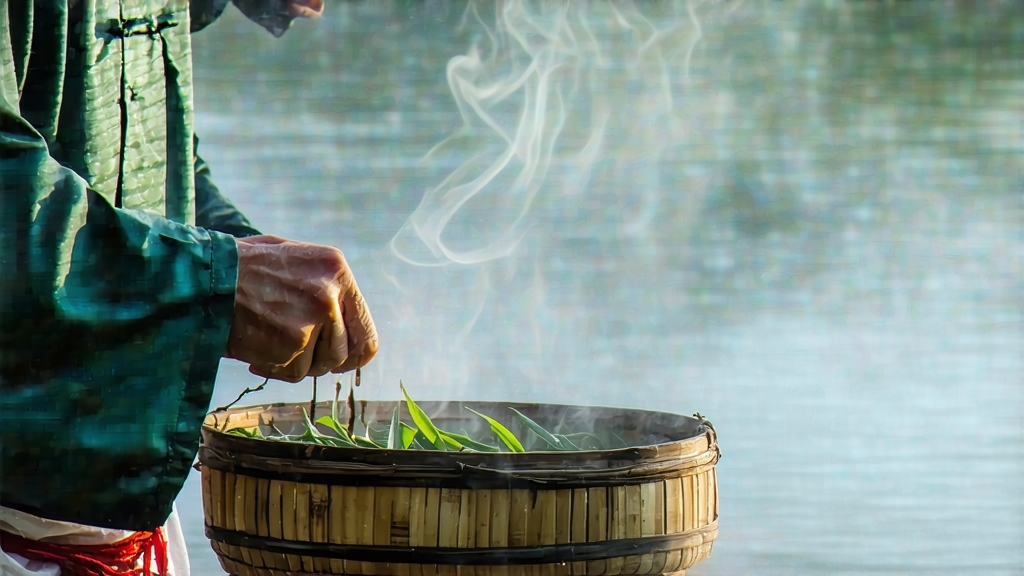
Longjing, literally “Dragon-Well,” is the most celebrated green tea in China and arguably the benchmark against which all other Chinese greens are measured. Grown on the hillsides that ring West Lake in Hangzhou, Zhejiang Province, this tea has been offered to emperors, shipped along the Grand Canal, and served at state banquets for more than twelve centuries. Yet its fame is not built on politics alone; a single sip reveals why poets compared it to “liquid jade” and why farmers still shape each leaf by hand in a wok hot enough to sting the palm.
Historical records first mention Longjing during the Tang dynasty (618-907 CE), but the tea entered the imperial spotlight in the Qing. The Qianlong Emperor, touring the south in 1751, was so enchanted by the tea bushes in front of Longjing Village’s Hugong Temple that he plucked a handful of leaves himself and tucked them into his sleeve. Court annals claim he later decreed that the eighteen bushes he touched be reserved for tribute, a privilege they retain to this day. Visitors can still see those bushes clinging to a rocky outcrop above the spring whose water supposedly resembles a coiled dragon, giving the tea its name.
Today Longjing is protected under China’s geographical-indication system; only leaves picked within the 168 km² core zone of Xihu (West Lake) District may legally bear the name “West Lake Longjing.” Even within this micro-region, connoisseurs distinguish three sub-areas: Shifeng (Lion Peak), Meijiawu, and Wengjiashan. Shifeng teas, grown on steep, mist-shrouded slopes of weathered shale, yield the smallest, most aromatic leaves. Meijiawu’s gentler hills produce a slightly fuller body, while Wengjiashan offers a greener, more vegetal cup. Beyond the lake, the same cultivar is grown in Qiantang, Yuezhou, and even as far as Yunnan, but these teas are labeled simply “Zhejiang Longjing” and fetch a fraction of the price.
The cultivar itself is a regional variant of Camellia sinensis var. sinensis known locally as quntizhong or longjingqunti. It buds early, contains unusually high levels of theanine, and has leaves whose underside is so downy that locals joke you can “see the frost in springtime.” In recent decades clonal selections such as Longjing #43 and Wuniuzao have been promoted for higher yield and earlier harvest, but purists insist the original quntizhong delivers the elusive “orchid-chestnut” fragrance that defines top grades.
Harvest begins around Qingming (early April) when nights are still cool and morning mist lingers like silk. Only the standard “one bud with one unfolding leaf” is plucked; anything larger is rejected. A skilled picker can gather barely half a kilogram of fresh leaves in a day, which will shrink to 100 g after firing. The choicest lot, mingqian tea picked before Qingming, can command over US $2,000 per 500 g at auction because the entire district produces less than 3,000 kg in a good year.
What truly sets Longjing apart, however, is its pan-firing craft. Within minutes of plucking, the leaves are spread thinly on bamboo trays to lose surface moisture. They are then tossed by hand into a wok heated to 80 °C, a temperature high enough to halt oxidative enzymes yet low enough to preserve chlorophyll. The master presses, shakes, and strokes the leaves for twelve to fifteen minutes, using only the faintest film of tea oil on the palm to prevent scorching. The motion is described by the onomatopoeic verbs “tremble, buckle, swing, straighten,” each designed to lock in fragrance while flattening the leaf into the characteristic sword-shaped strip. When done correctly, the leaf will snap cleanly when folded and emit a faint chestnut aroma that makes onlookers suddenly hungry. After the first firing the leaves rest for forty minutes, then return to a cooler wok (60 °C) for a second, gentler drying that reduces moisture to 5 %. No rolling, no roasting, no machines—just wrist and fire.
To brew Longjing well you need calm water, not boiling rage. Let freshly drawn water stand for three minutes after boiling, bringing it to roughly 80 °C. Glass is the traditional vessel because it allows the “three falls and three rises” of the leaves as they dance vertically—a performance known